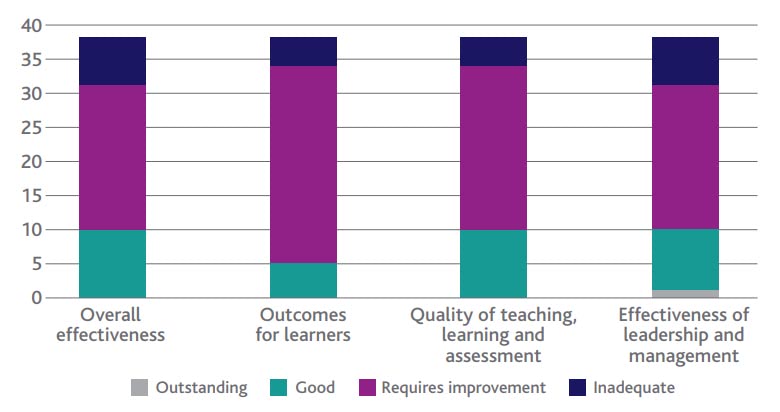The 5 causes of poor performance in FE

If you interrogate the data and read the Ofsted reports of poorly performing further education colleges, it is possible to identify a set of common causal issues… I reviewed the Ofsted reports of all 39 further education colleges which hit either my curriculum and/or financial performance criteria.
Chart 8: Underpinning Ofsted grades of colleges which hit curriculum or financial criteria

I wanted to make sure that my discussion of different approaches to transformation was rooted in the problems which most commonly need to be address through college transformations.
5 identified causes of poor performance in FE
1. Insufficient progress since the previous inspection
The vast majority of the reports talk, in one way or another, about colleges making insufficient progress since the previous Ofsted inspection and/or leaders’ failure to take timely and effective action to address identified areas for improvement.
Reports said things like:
- Governors and leaders have been too slow to bring about the required improvements in the quality of provision and outcomes for learners and apprentices.
- Leaders and managers have been too slow to implement the improvements recommended following the previous two inspections.
- Actions to improve outcomes for learners have not always been successful and the pace of improvement has often been too slow.
- Governors recognise that the pace of improvement has been too slow and have reviewed their oversight of the college to ensure that the pace of improvement increases.
2. A culture of low expectations
The majority of the reports talked, in one way or another, about leaders, managers and teachers having low expectations of and for their students.
Reports said things like:
- Teachers’ expectations are too low and too many learners make insufficient progress.
- Teachers’ expectations of learners are too low and do not sufficiently promote or reinforce the demands of employers, such as full attendance, punctuality and dress code.
- In most lessons, teachers’ expectations of what students can achieve are too low… Too many lessons lack pace and challenge and fail to stimulate learning.
3. Poor financial management
The majority of the reports talked, in one way or another, about poor financial management, including leaders’ failure to align resources with their teaching and learning improvement priorities.
Reports said things like:
- The college is in significant financial difficulties. Despite this, instances of poor financial management and unwise spending of public funds are frequent.
- Governors possess a wide range of pertinent skills in, for example, education, human resources, senior leadership and law, but financial expertise requires strengthening.
4. Lack of focus on areas for improvement
And/or Inaccurate self-assessment. A significant minority of the reports talked, in one way or another, about inaccurate or optimistic self assessment of curriculum quality and/or a lack of focus on – and focussed action in relation to – areas for improvement.
Reports said things like:
- Inspectors judge that leaders’ overall view of the quality of teaching is too generous.
- The self-assessment process is not fit-for-purpose. Leaders and managers do not identify sufficiently strengths and areas for improvement.
- Middle managers are not sufficiently skilled in critically evaluating their provision and, as a result, managers do not focus well enough on the priority areas for improvement.
5. Ineffective use of data
To understand and address areas for improvement. A significant minority of the reports talk, in one way or another, about a failure to use data to help them understand and address areas for improvement.
Reports said things like:
- Leaders do not make effective use of assessment information and other data to secure improvement.
- Governors do not scrutinise information and data provided to them sufficiently or challenge the senior management team to more rapidly improve the quality of teaching, learning and assessment, and outcomes for learners.
- Work-based learning managers have insufficient access to accurate in-year data to assess current performance and trends reliably.
I tested these conclusions with Paula Heaney, who was the regional lead Ofsted inspector when I first took up post at HLG. In that capacity she quality assured the June 2015 inspection of HLG and later provided us with exceptionally helpful advice, challenge and support as we continued our improvement journey ahead of our second inspection in November 2018.
She recognised these issues from her years of inspection experience – reinforcing the importance of strong leadership and management to college performance and improvement.
She suggested that colleges which are successful in transforming their performance focus relentlessly on the impact they’re having on students, and:
- Have a thorough understanding of their strengths and areas for improvement across all sites, provision types and subcontracted provision.
- Know what they need to improve, what actions they’re going to take, and how they’ll measure progress and success.
- Have well-defined and widely-communicated processes for regularly monitoring performance, including clear processes for tracking remedial and follow-up actions.
- Have well-developed processes for monitoring students’ progress so they can judge whether students are on-track and what support they may need.
- Have well-established processes through which leaders and governors use data to monitor and help drive performance improvements.
I will come back to several of the points Paula emphasised in chapters 5, 6 and 7.
The FE Commissioner’s annual report also identifies a set of common issues affecting poorly performing colleges, similar in nature to those identified through a review of Ofsted reports.
My analysis of Ofsted reports coheres reasonably well with the FE Commissioner’s conclusions, given his remit to work with further education colleges which need to improve their position. His annual report is another important source of insight into thinking about the issues common among poorly performing further education colleges.
During 2016/17, nine further education organisations, including five general further education colleges, were placed into FE Commissioner intervention having received Inadequate Ofsted grades.
In his annual report, the Commissioner notes that his recommendation to those organisations focussed on the following areas:
- Good quality management information presented transparently to the board for monitoring with the use of traffic light indicators and sector benchmarks.
- A strong focus on and championing of the student experience.
- A costed curriculum plan, showing cost margins for each course.
- Strengthened leadership and governance.
- A robust performance management system.
- A relentless focus, from governors and senior leaders, on improving teaching, learning and assessment.
His annual report also notes that 11 further education organisations were referred to the Commissioner for formal intervention for financial reasons during 2016/17.
The Commissioner’s recommendations to those organisations typically focussed on:
- A clear, costed curriculum plan setting out margins by course.
- Realistic, prudent and tested income targets which reflect demographic change and competitive pressures.
- Spending sufficient board time scrutinising budgets, capital and estate plans and in-year performance.
- Effective recruitment of leaders and managers with the right financial skills and experience.
- Clear benchmarking to monitor performance.
- A Commissioner-led structure and prospects appraisal.
The Commissioner also notes that action on leadership and governance is a consistent theme across all interventions. He notes that his recommendations in this area tend to focus on:
- Effective recruitment of governors with the necessary skills.
- A culture of challenge at board level.
- Commissioning independent reviews of governance arrangements.
- Clear board reporting, with transparent performance metrics and use of benchmarking.
- Governors developing their expertise and understanding of the college’s management, including through direct access to middle management.
- Mentoring and training programmes for senior leaders.
It is clear then that poorly performing colleges often share a set of common causal issues; their transformation must be rooted in and address these issues.
Matt Hamnett, Director, MH+A
Over the next few weeks FE News will be publishing this research in full, and FETL will be hosting a webinar with Matt on the report later in February.
Chapter One: The further education operating context is incredibly tough / The introduction of T levels
Chapter Two: College performance compared to other sectors
Chapter Three: The 5 causes of poor performance in FE
Chapter Four: Seven lenses of transformation for FE / FE Can Learn From The Success Of Other Sectors
Chapter Five: Good Strategy Is Crucial For FE Transformation / Policy Cycle Blights FE: Colleges Leaders Should Chart Their Own Course
Chapter Six: How to unleash the talent already in your college / Aligning organisational purpose, strategy and transformation priorities with available funding
Chapter Seven: Leading the transformation in FE











Responses